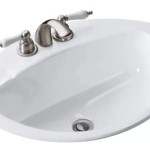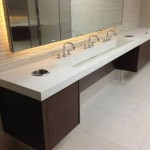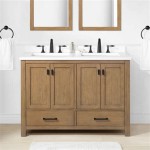White Bathroom Sink Vanity Units: A Comprehensive Guide
White bathroom sink vanity units are a popular choice for homeowners seeking a clean, bright, and versatile aesthetic in their bathrooms. Their widespread appeal stems from their adaptability to various bathroom styles, from traditional to modern, and their ability to create a sense of spaciousness. This article will delve into the key aspects of white bathroom sink vanity units, examining their benefits, different types, materials, design considerations, installation, and maintenance.
The Enduring Appeal and Benefits of White Vanity Units
The enduring appeal of white bathroom vanity units is multifaceted. Firstly, white is a timeless color that transcends fleeting trends. It remains a constant in interior design, offering a safe and stylish option for homeowners who want a look that will last for years. Secondly, white reflects light effectively, making even smaller bathrooms appear larger and brighter. This is particularly beneficial in bathrooms that lack natural light or have limited square footage. Thirdly, white serves as a neutral backdrop, allowing other bathroom elements, such as tiles, fixtures, and accessories, to stand out and contribute to the overall design scheme.
Beyond aesthetics, white vanity units offer practical benefits. They are generally easier to clean than darker-colored vanities, as dirt and watermarks are more visible and thus easier to spot and remove. The neutral color also allows for greater flexibility in decorating and redecorating the bathroom, as it readily complements a wide range of colors and styles. The resale value can also be positively impacted by a clean and classic white bathroom, as it appeals to a broader range of potential buyers.
Exploring Different Types of White Bathroom Vanity Units
White bathroom vanity units are available in a wide variety of styles and configurations to suit different bathroom layouts and personal preferences. Understanding these different types is crucial for selecting the right vanity for a specific space.
Freestanding Vanities: Freestanding vanity units are the most common type. These vanities stand on their own legs or a base, offering a traditional and versatile option. They are relatively easy to install and offer ample storage space behind closed doors or in drawers. Freestanding vanities are available in various sizes and styles, from simple and minimalist designs to more ornate and detailed options.
Wall-Mounted Vanities: Wall-mounted, or floating, vanity units are a contemporary choice that creates a sense of spaciousness and adds a modern touch to the bathroom. They are mounted directly to the wall, leaving the floor beneath them clear. This not only makes the bathroom appear larger but also simplifies cleaning. Wall-mounted vanities are available in a range of sizes and styles, often with sleek and minimalist designs. They require careful installation to ensure they are securely attached to the wall and can support the weight of the sink and countertop.
Corner Vanities: Corner vanity units are designed to fit snugly into the corner of a bathroom, maximizing space utilization in smaller bathrooms or irregularly shaped layouts. They typically feature a triangular or angled shape and offer storage space within the corner unit. Corner vanities are a practical solution for bathrooms where space is at a premium.
Double Sink Vanities: Double sink vanity units feature two sinks side-by-side, providing ample space for two people to use the bathroom simultaneously. These vanities are ideal for master bathrooms or shared bathrooms where multiple users are common. Double sink vanities are available in freestanding and wall-mounted configurations and often include a substantial amount of storage space beneath the sinks.
Vanity Cabinets with Tops: These are complete units that include both the cabinet base and the countertop. The countertop material can vary widely, including options like granite, marble, quartz, or solid surface materials. Choosing a vanity cabinet with a top simplifies the selection process and ensures a cohesive and coordinated look.
Vanity Bases Only: These are cabinet bases without a countertop. This allows homeowners to select a countertop separately, providing greater customization options. Choosing a vanity base only is ideal for those who have a specific countertop material or design in mind.
Materials and Construction of White Bathroom Vanity Units
The materials used in the construction of a white bathroom sink vanity unit play a significant role in its durability, appearance, and cost. Selecting the right materials is essential for ensuring a long-lasting and aesthetically pleasing vanity.
Wood: Solid wood is a traditional and durable material for vanity construction. It offers a warm and natural look and can be stained or painted in any color, including white. However, solid wood is susceptible to moisture damage and requires proper sealing and maintenance to prevent warping or cracking. Hardwoods like maple, oak, and birch are commonly used for vanity construction due to their strength and durability.
Plywood: Plywood is an engineered wood product made from layers of wood veneer glued together. It is more resistant to moisture damage than solid wood and is a more affordable option. High-quality plywood with a water-resistant finish is a suitable material for bathroom vanities.
MDF (Medium-Density Fiberboard): MDF is another engineered wood product made from compressed wood fibers. It is a smooth and stable material that is ideal for painting. MDF is less expensive than solid wood and plywood, but it is also more susceptible to moisture damage. It is essential to choose MDF with a water-resistant coating for use in a bathroom vanity.
PVC (Polyvinyl Chloride): PVC is a synthetic plastic polymer that is completely waterproof and resistant to moisture damage. It is a durable and low-maintenance option for bathroom vanities, particularly in high-humidity environments. PVC vanities are available in various styles and finishes, including white.
Melamine: Melamine is a type of laminate made from a thermosetting plastic resin. It is applied to a substrate, such as particleboard or MDF, to create a durable and water-resistant surface. Melamine is an affordable option for bathroom vanities and is available in a wide range of colors and patterns, including white.
Countertop Materials: The countertop material is a critical component of a vanity unit and can significantly impact its overall look and functionality. Common countertop materials include:
*Granite: A natural stone that is durable, heat-resistant, and available in a wide range of colors and patterns. *Marble: A luxurious natural stone that is known for its elegance and unique veining. *Quartz: An engineered stone that is highly durable, stain-resistant, and available in a wide range of colors and patterns. *Solid Surface: A synthetic material that is non-porous, seamless, and available in a wide range of colors and patterns. *Laminate: An affordable option that is available in a wide range of colors and patterns and is relatively easy to maintain.
The construction of the vanity unit also plays a role in its durability. Look for vanities with solid construction, sturdy drawers, and well-attached hardware. Dovetail joints are a sign of quality craftsmanship and indicate a strong and durable drawer construction.
Design Considerations: Style, Size, and Storage
Selecting the right white bathroom sink vanity unit involves careful consideration of the bathroom's style, size, and storage needs. Ensuring that the vanity complements the overall design and provides adequate storage is crucial for creating a functional and aesthetically pleasing bathroom.
Style: The style of the vanity should complement the overall design of the bathroom. For a traditional bathroom, a white vanity with raised panel doors, ornate details, and a classic countertop material like marble or granite would be a suitable choice. For a modern bathroom, a white vanity with sleek lines, minimalist hardware, and a contemporary countertop material like quartz or solid surface would be more appropriate. Shaker-style vanities offer a versatile option that can work well in both traditional and modern bathrooms.
Size: The size of the vanity should be proportionate to the size of the bathroom. In a small bathroom, a compact vanity or a wall-mounted vanity will help maximize space. In a larger bathroom, a double sink vanity or a larger freestanding vanity can provide ample storage and countertop space. It is essential to measure the available space carefully before selecting a vanity to ensure that it fits comfortably and allows for adequate clearance around the sink and toilet.
Storage: The storage needs of the bathroom should also be considered when selecting a vanity. Think about the items that need to be stored in the vanity, such as toiletries, towels, cleaning supplies, and personal care products. Choose a vanity with adequate drawers, cabinets, and shelves to accommodate these items. Vanities with adjustable shelves and drawer organizers can help maximize storage space and keep the bathroom organized.
Hardware: The hardware on the vanity, such as knobs, pulls, and hinges, can also impact its overall look and functionality. Choose hardware that complements the style of the vanity and is durable and easy to use. Common hardware finishes include chrome, brushed nickel, oil-rubbed bronze, and black. The hardware should also be resistant to moisture damage and corrosion.
Lighting: Integrating lighting into the vanity design can enhance its functionality and aesthetics. Consider adding under-cabinet lighting to illuminate the countertop or installing a lighted mirror to provide task lighting for grooming. The lighting should be bright and even to provide adequate illumination for the bathroom.
Plumbing: It is essential to consider the plumbing requirements when selecting a vanity. Ensure that the vanity is compatible with the existing plumbing and that the drain location aligns with the sink. If necessary, consult with a plumber to determine the best vanity configuration for the bathroom.
Accessibility: For individuals with disabilities or mobility limitations, consider selecting a vanity that meets accessibility standards. This may involve choosing a vanity with a lower countertop height, ample knee space, and easy-to-reach hardware.
Installation and Maintenance of White Bathroom Vanity Units
Proper installation and regular maintenance are essential for ensuring the longevity and appearance of a white bathroom sink vanity unit. Installing the vanity correctly will prevent issues such as leaks, sagging, and damage to the surrounding walls and floors. Regular maintenance will keep the vanity clean, hygienic, and looking its best.
Installation: Installing a vanity unit can be a relatively straightforward process for experienced DIYers. However, it is often recommended to hire a professional plumber or contractor to ensure that the installation is done correctly and safely. The installation process typically involves the following steps:
*Removing the old vanity: Carefully disconnect the plumbing and remove the old vanity from the bathroom. *Preparing the space: Clean the area where the new vanity will be installed and repair any damage to the walls or floors. *Installing the vanity: Follow the manufacturer's instructions to install the new vanity, ensuring that it is level and securely attached to the wall. *Connecting the plumbing: Connect the sink drain, water supply lines, and other plumbing fixtures to the vanity. *Sealing the vanity: Apply caulk around the edges of the vanity to prevent water damage. *Installing the countertop: Install the countertop on top of the vanity, ensuring that it is level and securely attached. *Installing the sink: Install the sink into the countertop, following the manufacturer's instructions. *Checking for leaks: Carefully inspect all plumbing connections for leaks and make any necessary adjustments.
Maintenance: Regular maintenance is essential for keeping a white bathroom vanity unit clean and looking its best. Wipe down the vanity regularly with a soft cloth and mild soap to remove dirt, dust, and watermarks. Avoid using harsh chemicals or abrasive cleaners, as they can damage the finish of the vanity. Periodically inspect the plumbing connections for leaks and make any necessary repairs. Clean the sink and countertop regularly to prevent stains and buildup. Apply a sealant to the countertop periodically to protect it from moisture damage. Keep the vanity well-ventilated to prevent moisture buildup and mildew growth.

Attractive Bathroom Vanity Wall Mounted Units In

Buy Bathroom Vanity Unit Sink Washstand Slimline White Painted In

Buy Bathroom Vanity Unit Sink Washstand Slimline White Painted In

Large Size Pvc Bathroom Vanity Unit Ceramic Washbasin Washroom Furniture Cabinet China Made In Com

Buy Classic Bathroom Vanity Designs Single Sink Fuao

Bathroom Wash Basin Vanity Unit With Cabinet For Storage By Miza Lorange Com

Fuao Sanitaryware Dark Brown Color Including Basin In White With Shades Of Beautiful Vanishing Bathroom Vanity

Elegant Wall Mounted White Bathroom Vanity Unit And Sink Basin Home Furniture

Buy Bathroom Painted Vanity Unit Corner Sink Cabinet In

Vevelux Bathroom Vanity White Ubuy
Related Posts







